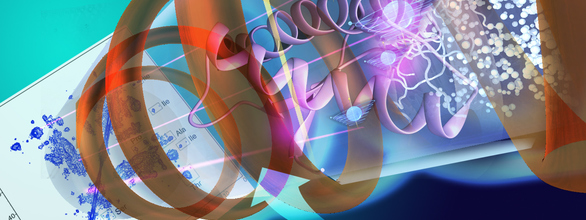
Overview
NMR spectroscopy of solid state has long been an important area of research in the Pines group. The group has been involved with a broad range of concepts, theory, techniques, instrumentation, and applications of solid state NMR. The consistent goals are to improve the spectral resolution, sensitivity, and selectivity of the NMR signal from nuclei hosted in condensed matter. The development of capabilities in terms of instrumentation and high frequency magic-angle spinning methods, multidimensional dipolar recoupling pulse sequences, and sample preparation techniques have made SSNMR a powerful analytical tool. SSNMR techniques are widely used in chemical, physical and biological systems, including polymers, liquid crystals, catalysts, glasses, semiconductors, meso- and nano- porous materials. In particular, SSNMR has become a promising technique for atomic-resolution structure determination of proteins involved in a wide range of disorders and human diseases. The concepts and theories developed originally in the field of SSNMR have direct impact on our recent studies involving atom-like defect centers in diamond.
Background
Solid state NMR spectroscopy is inherently more complicated than its liquid state counterpart. This arises from the appearance of anisotropic interactions, such as dipole-dipole coupling and nuclear quadrupolar that would be averaged to zero in an isotropic liquid. These interactions have several effects. One is the broadening of the NMR spectrum, obscuring chemical shift information. Methods to overcome this broadening are the foundation of solid-state NMR. However, these complex interactions also provide the opportunity to gain greater information from the NMR spectrum. For example, probing the dipole-dipole couplings between nuclear spins can show the spatial arrangement of atoms and quadrupolar splittings are a probe of the local electric field gradients. Relaxation timescales and lineshapes can also inform about dynamics in systems such as porous media.
History
The unique challenges of solid-state NMR have required a series of innovations over the last 40-50 years. These include “magic-angle spinning” in order to remove the complicated dipole-dipole interaction and dynamic nuclear polarization to increase sensitivity. Some contributions from the Pines lab include cross-polarization from protons to dilute spins to achieve enhanced sensitivity1, multiple-quantum spectroscopy to increase resolution2, and double rotation spinning to remove the nuclear quadrupolar interaction3. Modern solid-state NMR is now employed across a wide range of fields including solid-state physics in semiconductors, materials science and engineering, and study of large biomolecules.
Current Work
Current work in our lab involves the application of solid state NMR techniques and theories to solid state polarization and detection, NV spin dynamics, and subsequent hyperpolarization transfer to liquids.
Current Members
Aleks Kijac
Jonathan King
Claudia Avalos
Haijing Wang
Chang Shin
Anna Parker
John Blanchard
Tobias Sjolander
Collaborators
David Wemmer (UC-Berkeley, Chemistry)
Stanley Prusiner (UCSF, IND)
Dmitry Budker (UC-Berkeley, Physics)
References
[1] A. Pines, M. G. Gibby, J. S. Waugh, Proton-Enhanced Nuclear Induction Spectroscopy. A Method for High Resolution NMR of Dilute Spins in Solids, J. Chem. Phys. 56, 1776-1777 (1972).
[2] G. Drobny, A. Pines, S. Sinton, D. Weitekamp, and D. Wemmer, Fourier Transform Multiple Quantum Nuclear Magnetic Resonance, Faraday Division of the Chemical Society Symposium 13, 49-55 (1979).
[3] B. F. Chmelka, K. T. Mueller, A. Pines, J. Stebbins, Y. Wu, J. W. Zwanziger, Oxygen-17 NMR in Solids by Dynamic-Angle Spinning and Double Rotation, Nature 339, 42-43 (1989).
